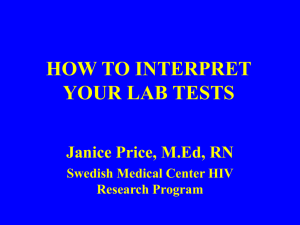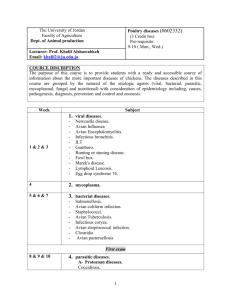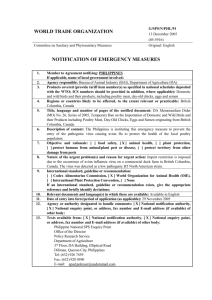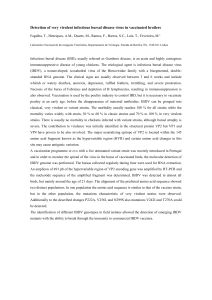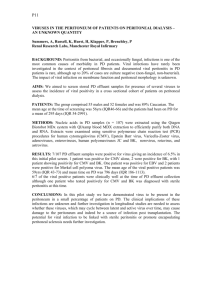Document 11138909
advertisement
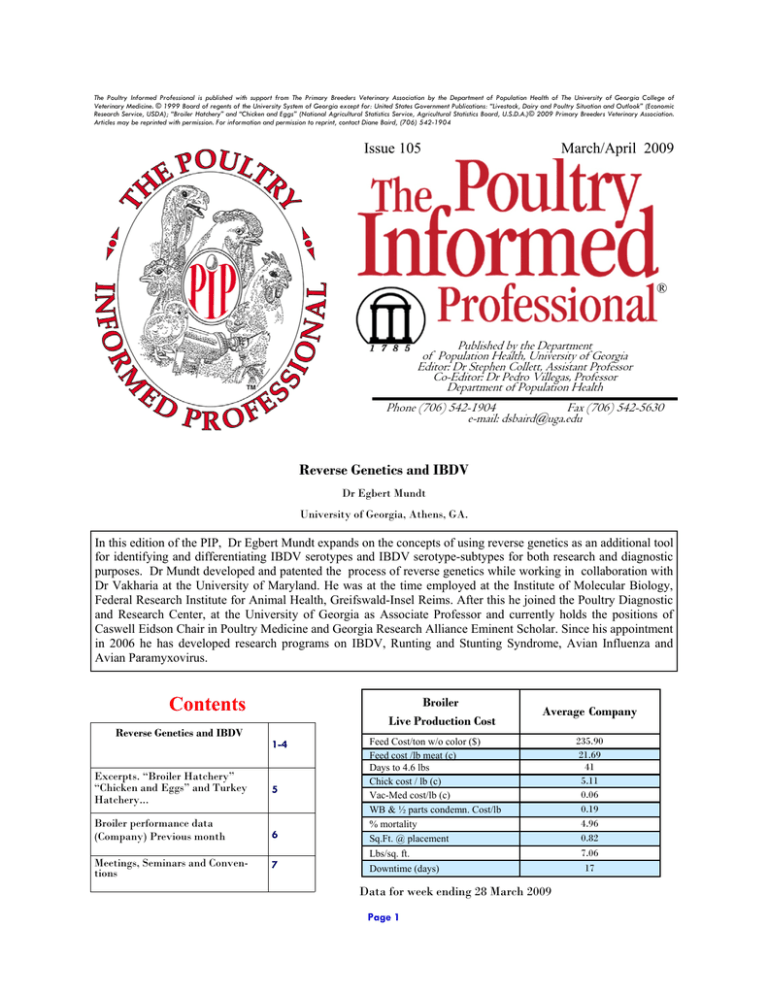
The Poultry Informed Professional is published with support from The Primary Breeders Veterinary Association by the Department of Population Health of The University of Georgia College of Veterinary Medicine. © 1999 Board of regents of the University System of Georgia except for: United States Government Publications: “Livestock, Dairy and Poultry Situation and Outlook” (Economic Research Service, USDA); “Broiler Hatchery” and “Chicken and Eggs” (National Agricultural Statistics Service, Agricultural Statistics Board, U.S.D.A.)© 2009 Primary Breeders Veterinary Association. Articles may be reprinted with permission. For information and permission to reprint, contact Diane Baird, (706) 542-1904 Issue 105 March/April 2009 ® Published by the Department of Population Health, University of Georgia Editor: Dr Stephen Collett, Assistant Professor Co-Editor: Dr Pedro Villegas, Professor Department of Population Health Phone (706) 542-1904 Fax (706) 542-5630 e-mail: dsbaird@uga.edu Reverse Genetics and IBDV Dr Egbert Mundt University of Georgia, Athens, GA. In this edition of the PIP, Dr Egbert Mundt expands on the concepts of using reverse genetics as an additional tool for identifying and differentiating IBDV serotypes and IBDV serotype-subtypes for both research and diagnostic purposes. Dr Mundt developed and patented the process of reverse genetics while working in collaboration with Dr Vakharia at the University of Maryland. He was at the time employed at the Institute of Molecular Biology, Federal Research Institute for Animal Health, Greifswald-Insel Reims. After this he joined the Poultry Diagnostic and Research Center, at the University of Georgia as Associate Professor and currently holds the positions of Caswell Eidson Chair in Poultry Medicine and Georgia Research Alliance Eminent Scholar. Since his appointment in 2006 he has developed research programs on IBDV, Runting and Stunting Syndrome, Avian Influenza and Avian Paramyxovirus. Contents Reverse Genetics and IBDV Broiler Live Production Cost 1-4 Excerpts. “Broiler Hatchery” “Chicken and Eggs” and Turkey Hatchery... 5 Broiler performance data (Company) Previous month 6 Meetings, Seminars and Conventions 7 Average Company Feed Cost/ton w/o color ($) Feed cost /lb meat (c) Days to 4.6 lbs Chick cost / lb (c) Vac-Med cost/lb (c) WB & ½ parts condemn. Cost/lb % mortality Sq.Ft. @ placement Lbs/sq. ft. Downtime (days) Data for week ending 28 March 2009 Page 1 235.90 21.69 41 5.11 0.06 0.19 4.96 0.82 7.06 17 Infectious bursal disease (IBD) is a highly contagious viral disease of chickens that was first described by Cosgrove in 1962. The causative agent, infectious bursal disease virus (IBDV) is a non-enveloped virus belonging to the family Birnaviridae. The name Birnaviridae is derived from the fact that there are two segments of double-stranded RNA (bi-rna) within the viral capsid. Two IBDV serotypes (1 and 2) have been identified by means of a cross neutralization assay. While serotype 2 has not been associated with disease in any species, serotype 1 is known to cause immune suppressive disease in chicken. Serotype 1 IBDV infection causes immune suppression because the target cell for viral replication is the immature B cells of the bursa of Fabricius. Through lytic infection of these developing B cells the virus causes B lymphocyte depletion which reduces antibody production capability, thus compromising the humoral immune response. The extent of immunosuppression is proportional to the virulence of the virus. Individual strains differ markedly in virulence and are classified as pathotypes, based on their ability to cause disease. In addition to causing immune suppression, serotype 1 isolates can cause high mortality in naïve immature (3-11 week-old) chickens. Naϊve chickens are most susceptible to clinical disease between 3 to 6 weeks of age. Chickens younger than three weeks of age do not usually develop clinical disease and chickens older than 11 weeks-of-age, have insufficient target cells (developing B-lymphocytes) for virus replication to generate clinical disease. Until the mid 1980’s, serotype 1 infection was controlled by vaccinating birds with live attenuated vaccines, inactivated vaccines or a combination of both. In the late 1980s a new IBDV serotype I pathotype emerged in Europe and subsequently became known as very virulent IBDV. Infection with this pathotype was initially detected in the Netherlands and described by Box in 1989 as being characterized by a peracute onset of disease with unusually high mortality. The virus spread rapidly to every poultry producing country except those on the North American continent. Although the antigenic makeup of this new serotype 1 subtype was, and still is very similar to the original IBD virus ( now referred to as classic strain IBDV) it was able to break through the existing level of maternally derived protection. Interestingly, at approximate the same time a new IBDV serotype 1 subtype emerged on the North American continent. This subtype (later called variant IBDV) was characterized by an unusual phenotype. These variant strain viruses were able to infect immature proliferating B lymphocytes, cause cell lysis and hence B-lymphocyte depletion without eliciting an inflammatory response or clinical signs of disease. The new IBDV subtype was described by Saif (1984) and Rosenberger et al. (1985, 1987) in the mid 1980’ and it was later shown that this variant virus was also antigenically different. Although the variant virus was clearly a serotype 1 virus, it was sufficiently different from the classic strain IBDV to break through immunity induced by established vaccinations programs. Within the group of variant strain IBD viruses several antigenically different isolates have been described, including E/Del, Variant A, and GLS. Characterization of these new antigenic subtypes was initially done by cross neutralization assay and later made possible through the use of monoclonal antibodies (Snyder et al., 1988a, 1988b, 1992). The emergence of these variant strain viruses was a challenge to the poultry industry since the vaccination programs based on classic strain IBDV were no longer effective and yet these classic IBD viruses were still circulating. With so many different IBD viruses (classic strain, very virulent IBD virus and several variant strain viruses) circulating in the field, there was an obvious need for improvements in diagnostic techniques. In response to this need molecular technologies were utilized to improve the existing diagnostic tools. Since viral proteins which are part of the outer viral surface are important in cell surface receptor recognition and attachment, focus shifted to identifying and characterising these viral proteins. The viral capsid which acts like a shell for the viral genome is made exclusively from a protein designated VP2 (Coulibaly et al., 2005). Besides VP2, four other IBD viral proteins were identified and designated VP1 Page 2Page 2 and VP3 through VP 5. VP1 is an RNA dependant-RNA-polymerase (RdRp) which is encoded for by genomic segment B. This RNA-dependent polymerase is responsible for viral RNA replication after infection of the cell. The proteins VP2, VP3, VP4 and VP5 are encoded for by genomic segment A. VP2, VP3, and VP4 are initially synthesised as a single molecule or polyprotein which is subsequently cleaved into its components by the viral protease VP4. The exact function of VP3 is still unclear but research indicates that it is most likely involved with the process of viral genome (RNA) replication and capsid formation. Recently, it has been shown that VP3 is associated with the viral RNA as a ribonucleoprotein. VP5 is encoded for on a separate operating reading frame (ORF). This non-structural protein is probably involved with the process of viral particle release from the infected cell after viral replication is complete. A detailed knowledge of the antigenic structure of the surface protein (VP2) is essential for effective vaccination program design. The viral capsid protein, VP2 is the only known viral protein able to induce neutralizing antibodies and is therefore pivotal in determining IBDV serotype and IBDV serotype subtype differences. In 1990 it was shown that a small portion of the VP2 molecule is more prone to variation than the rest of the viral proteins. The part of the viral genome that encodes for this variable fragment of the capsid protein is referred to as the “variable region” of VP2 (Bayliss et al., 1990). Since it is crucial to be able to distinguish the various IBDV subtypes (classic, very virulent, variant) and the variant subtypes (E/Del, GLS, Variant A etc.) the variable region of the VP2 protein became the point of focus for diagnostic test development. The idea of using monoclonal antibodies to distinguish between serotype-1 subtypes (Snyder et al., 19988a, 19988b, 1992) based on VP2 variable region structural differences had already proven to be a powerful diagnostic tool. This method was made simpler by the development of an AC-ELISA (Van der Marel et al, 1990). The limited availability of the monoclonal antibodies and the rapid advancement in understanding of exactly what part of the viral genome encoded for the variable region of the VP2 protein drew research focus to the nucleotide sequence of the variable region. With the advent of high throughput molecular techniques it became conceivably possible to use the nucleotide sequence of the variable region to distinguish serotypes and subtypes. To this end, the nucleotide sequence of the part of the genome encoding for the VP2- variable region was determined. This process involved converting that RNA sequence into its complementary DNA (cDNA) by reverse transcription (RT), amplifying the cDNA by polymerase chain reaction (PCR) and establishing the nucleotide sequence of this amplified RT-PCR fragment. As this technique gained in popularity, the amount of the sequence data for the VP2 variable region increased. It soon became possible to compare new and existing isolates with bioinformatics analysis to establish a measure of isolate similarity based on phylogeny. This was however not an option for routine diagnostics. Following the success of Jackwood’s group in using restriction enzyme fragment length polymorphisms (RFLP) to separate IBDV isolates into molecular groups (Jackwood et al.,1994, 1997, 1998) an attempt to group IBDV isolates by real-time RT-PCR was initiated. Using this procedure it was possible to refine the focus of the nucleotide sequences determination to that part of the RNA that encoded for the antigenic epitope thus grouping them into antigenotypes based on nucleotide sequences (Jackwood et al, 2003). The disadvantage of using this method as a diagnostic tool to differentiate antigenotypes (e.g. E/Del, GLS, classic) was that degenerative changes in the IBD virus RNA could lead to an incorrect diagnosis since different nucleotide sequences (here nucleotide triplets) can encode for the same amino acid. Thus a change in the nucleotide sequence does not necessarily lead to a change in the amino acid sequence or antigenicity of VP2. To complicate the situation further, Letzel et al. (2007) showed that changes in the amino acid sequence located 100 amino acids apart could cause a switch from a classic to an E/Del antigenotype. Clearly a more comprehensive analysis of the nucleotide sequence, amino acid sequence and antigenotype would be necessary before this method could be used effectively for serotype diagnosis. In this context it needs to be considered that the use of autogenous vaccines by almost every poultry company in the US may have caused an additional antigenic drift of IBDV on a regional basis. Page Page 3 3 In an attempt to solve this problem, a technique referred to as a reverse genetics system for IBDV (RGS-IBDV) was employed. Reverse genetics with RNA viruses (such as IBDV) is nothing more than creating a new virus from viral cDNA. This process allows the manipulation of viral phenotype since the protocols and tools (enzymes) for cDNA manipulation are freadily available. Segment A IBDV Segment B Reverse transcription into cDNA Segment A cDNA Segment A cRNA Segment B cDNA Transcription into viral cRNA promoter promoter The process of reverse genetics as applied to IBDV was developed by Mundt and Vakharia (1996) and is illustrated in figure 1. Initially, IBD viral RNA is reverse transcribed into cDNA. This viral cDNA is now under the control of a promoter sequence which acts as a binding site for a promoter-specific enzyme which, once bound, is able to transcribe viral cDNA back into viral cRNA. By transfecting this viral cRNA into a host cell and allowing virus replication to start, it is possible to retrieve or rescue an identical copy of the parent virus. Segment B cRNA By combining these three techniques it is Transfection of cRNA now possible to determine the nucleotide into a cell sequence, the amino acid sequence by in silico translation (using a computer program), and determine the mAb reaction panel pattern. The individual steps of the method are illustrated in figure 2. In a first step, the viral nucleotide sequence of the part encoding the variable region of VP2 Generation of present in the bursal tissue sample is ampliinfectious virus Segment A fied by RT-PCR. The RT-PCR fragments IBDV Segment B are then sequenced and translated in silico into their amino acid sequence. These nucleotide and amino acid sequences are stored in a data base for later analysis. Figure 1: Reverse Genetics System of Infectious Bursal Disease Virus. The viral RNA of both genomic segments (A and The next step is to establish the antigenic B) are transcribed into complementary DNA (cDNA) by phenotype of the virus. The cDNA fragreverse transcription (RT) followed by an amplification step ment representing the complimentary cRNA sequence that encodes for the vari- employing the polymerase chain reaction (PCR). The resulting RT-PCR fragments of segment A and B are located unable region of VP2 of the field virus is der the control of a promoter sequence. An enzyme which transferred into an IBDV reverse genetics needs the promoter sequence as starting point transcribes the system based on the D78 vaccine strain viral cDNA in viral cRNA. The obtained viral cRNA will be IBDV. The part of cRNA that encodes for transferred into a susceptible cell and virus progeny can be the variable region of VP2 is thus transisolated. ferred to the newly formed viral pprotein which therefore display the field isolate antigen (Icard et al., 2008). Once transfection has occurred, transfected cells are fixed and the antigenotype subsequently determined by immunofluorescence using the mAb panel established by Snyder et al.. The panel pattern is recorded and added to the database for later analysis. Page 4 Finally, nucleotide sequence, amino acid sequence, and the Segment A panel patterns are now used for diagnostic purposes. Since field sample VP5 a single amino acid substituVP3 VP4 tion can change antigenic RT-PCR phenotype, only those with VP2frag identical amino acid seLigation Sequencing quences are classed as the same antigenotype. As the nt sequence database grows so too does VP5 VP3 VP4 VP2frag the chance of having a matchAnalysis ing sequences (hit-rate) with known panel patterns database mAb panel pattern (antigenotype), thus increasTransfection nt aa mAb pp by immunofluorescence ing the diagnostic relevance of the amino acid sequences obtained from field isolates. At the very least it aids in vaccination program design and monitoring since the antigenic makeup of the vaccine Figure 2: Analysis of the antigenicity of Infectious Bursal Disease Virus using the reverse genetics system. The viral RNA of a bursal samples suspected to virus can be compared dicontain IBDV will be used to transcribe into cDNA of the IBDV variable rectly with the antigenic region located in VP2 by reverse transcription (RT). The obtained cDNA will makeup of the circulating be amplified by a polymerase chain reaction (PCR). The resulting RT-PCR field strains. What is critical fragment will be used for two approaches. i) Sequencing to obtain the nucleothough is that this process tide (nt) sequence which can be translated into the amino acid (aa) sequence avoids the false-positive and by using bioinformatics tools. ii) The fragment will be ligated into a approfalse-negative results, repriate prepared segment A to obtain a chimeric viral segment A. This viral cently shown to occur when cDNA will now be transcribed into viral cRNA and used in the reverse the nucleotide sequence is used on its own (Icard et al., 2008). In summary, field isolate nucleotide sequence analysis by means of RT-PCR amplification followed by RFLP or phylogenic analysis alone is no longer a reliable means of determining IBDV antigenotype. By combining amino acid sequence data with the mAb reaction panel pattern it is however possible to establish, categorize and compare the antigenic makeup of field isolates. Using the latter method in a recent analysis of field isolates several of the viral isolates failed to react with the mAb panel. This indicates that there are several circulating IBD viruses that are antigenically distinct from the known subtypes. Characterization of these subtypes is currently underway. Unfortunately, reverse genetics is only the first step in the discovery of “new” antigenotypes. References: Bayliss, C. D., Spies, U., Shaw, K., Peters, R. W., Papageorgiou, A., Müller, H., and M. E. G. Boursnell. A comparison of the sequencesof segment A of four infectious bursal disease virus strains and identification of a variable region in VP2. J Gen. Virol. 71:1303-1312. 1990. Cosgrove, A. S. An apparently new disease of chickens - avian nephrosis. Avian Diseases 6, 385-389. 1962. Rosenberger, J. K., Cloud, S. S., Gelb, J., Odor, E., and S. E. Dohms. Sentinel Birds survey of Delmarva broiler flocks, p. 94101. In Proceedings of the 20th National Meeting on Poultry Health and Condemnation, Ocean City, MD. 1985. Coulibaly, F., Chevalier, C., Gutsche, I., Pous, J., Navaza, J., Bressanelli, S., Delmas, B., and F. A. Rey. The birnavirus crystal structure reveals structural relationships among icosahedral viruses. Cell 120, 761-772. 2005. Icard, A. H., Sellers, H. S. and E. Mundt. Detection of Infectious Bursal Disease Virus isolates with unknown antigenic properties by reverse genetics. Avian Dis. 52, 590–598. 2008. Page 5 Jackwood, D. J., and R. J. Jackwood. Infectious bursal disease viruses: molecular differentiation of antigenic subtypes among serotype 1 viruses. Avian Dis. 38:531–537. 1994. Jackwood, D. J., and C. K. Nielsen. Detection of infectious bursal disease viruses in commercially reared chickens using the reverse transcriptase/polymerase chain reaction–restriction endonuclease assay. Avian Dis. 41:137–143. 1997. Jackwood, D. J., Spalding, B. D., and S. E. Sommer. Real-time reverse transcriptase-polymerase chain reaction detection and analysis of nucleotide sequences coding for a neutralizing epitope on infectious bursal disease viruses. Avian Dis. 47:738744. 2003. Jackwood, D. J., and S. E. Sommer. Genetic heterogeneity in the VP2 gene of infectious bursal disease viruses detected in commercially reared chickens. Avian Dis. 42:321–339. 1998. Letzel, T., Coulibaly, F., Rey F. A., Delmas, B., Jagt, E., van Loon, A. A. M. W., and E. Mundt. Molecular and structural bases for the antigenicity of VP2 of infectious bursal disease virus. J. Virol. 81: 12827-12835. 2007. Mundt, E., and V. N. Vakharia. Synthetic transcripts of double-stranded Birnavirus genome are infectious. Proc. Natl. Acad. Sci. U S A 93: 11131-11136. 1996. Rosenberger, J. K., Cloud, S. S., and A. Metz. Use of infectious bursal disease virus variant vaccines in broilers and broiler breeders, p. 105-109. In Proceedings of the 36th Western Poultry Disease Conference, Davis, CA. 1987 Saif, Y. M. Infectious bursal disease virus type, p. 105-107. In Proceedings of the 19th National Meeting On Poultry Health and Condemnations, Ocean City, MD, 1984. Snyder, D. B., Lana, D. P., Cho, B. R., and W. W. Marquardt. Group and strain-specific neutralization sites of infectious bursal disease virus defined with monoclonal antibodies. Avian Dis 32: 527-534. 1988a. Snyder, D. B., Lana, D. P., Savage, P. K., Yancey, F. S., Mengel, S. A., and W. W. Marquardt. Differentiation of infectious bursal disease virus directly from infected tissues with neutralizing monoclonal antibodies: evidence of a major antigenic shift in recent field isolates. Avian Dis. 32:535–539. 1988b. Snyder, D. B., Vakharia, V. N., and P. K. Savage. Naturally occurring-neutralizing monoclonal antibody escape variants define the epidemiology of infectious bursal disease viruses in the United States. Arch Virol. 127: 89-101. 1992. Van der Marel, P., Snyder D., and D. Lütticken. Antigenic characterization of IBDV field isolates by their reactivity with a panel of monoclonal antibodies. Dtsch. Tieraerztl. Wochenschr. 97: 81-83. 1990. Annual Avian Mycoplasma Diagnostic Workshop In March the PDRC hosted the annual Avian Mycoplasma Workshop, sponsored by the National Poultry Improvement Plan, the Poultry Diagnostic and Research Center, the National Veterinarian Service Laboratories, Intervet-Shering Plough, Idexx Labs., Synbiotics, Mar-Jac Poultry and the Georgia Egg Association. These training workshops have helped to ensure that a very high standard of consistent Mycoplasma diagnostic service is available country wide, arguably one of the most important requirements for the effective control/eradication of Mycoplasma. The combination and balance of theory and hands on laboratory training has proven to be extremely popular over the years, 2009 being no exception. Pictured below is the cheerful “Class of 2009”. Page 6 Excerpts from the latest USDA National Agricultural Statistics Service (NASS) “Broiler Hatchery,” “Chicken and Eggs” and “Turkey Hatchery” Report and Economic Research Service (ERS) “Livestock, Dairy and Poultry Situation Outlook” Chicken and Eggs Released January 23, 2009 , by the National Agricultural Statistics Service (NASS) December Egg Production Down Slightly U.S. egg production totaled 7.78 billion during December 2008, down slightly from last year. Production included 6.71 billion table eggs, and 1.07 billion hatching eggs, of which 1.00 billion were broiler-type and 67 million were egg-type. The total number of layers during December 2008 averaged 341 million, down 1 percent from last year. December egg production per 100 layers was 2,281 eggs, up 1 percent from December 2007. All layers in the U.S. on January 1, 2009 totaled 341 million, down 1 percent from last year. The 341 million layers consisted of 285 million layers producing table or market type eggs, 53.6 million layers producing broiler-type hatching eggs, and 2.81 million layers producing egg-type hatching eggs. Rate of lay per day on January 1, 2009, averaged 72.9 eggs per 100 layers, up 1 percent from January 1, 2008. Egg-Type Chicks Hatched Up 1 Percent Egg-type chicks hatched during December 2008 totaled 36.4 million, up 1 percent from December 2007. Eggs in incubators totaled 36.7 million on January 1, 2009, up 2 percent from a year ago. Domestic placements of egg-type pullet chicks for future hatchery supply flocks by leading breeders totaled 199 thousand during December 2008, down 19 percent from December 2007 . Broiler-Type Chicks Hatched Down 5 Percent Broiler-type chicks hatched during December 2008 totaled 779 million, down 5 percent from December 2007. Eggs in incubators totaled 630 million on January 1, 2009, down 7 percent from a year earlier. Leading breeders placed 6.58 million broiler-type pullet chicks for future domestic hatchery supply flocks during December 2008, down 9 percent from December 2007 earlier. Average hatchability for chicks hatched during the week was 84 percent. Average hatchability is calculated by dividing chicks hatched during the week by eggs set three weeks earlier. Broiler Chicks Placed Down 6 Percent Broiler growers in the 19-State weekly program placed 168 million chicks for meat production during the week ending January 24, 2009. Placements were down 6 percent from the comparable week a year earlier. Cumulative placements from December 28, 2008 through January 24, 2009 were 672 million, down 6 percent from the same period a year earlier Turkey Hatchery Released January 15, 2009 , NASS, Agricultural Statistics Board, USDA Eggs in Incubators on January 1 Down 6 Percent from Last Year Turkey eggs in incubators on January 1, 2009, in the United States totaled 29.7 million, down 6 percent from January 1, 2008. Eggs in incubators were up 7 percent from the December 1, 2008 total of 27.8 million eggs. Regional changes from the previous year were: East North Central down 3 percent, West North Central down 4 percent, North and South Atlantic down 6 percent, and South Central and West down 16 percent . Poults Hatched During October Down 3 Percent from Last Year Turkey poults hatched during December 2008, in the United States totaled 24.3 million, down 3 percent from December 2007. Poults hatched were up 10 percent from November 2008 total of 22.0 million poults. Regional changes from the previous year were: East North Central down 5 percent, West North Central up 1 percent, North and South Atlantic up 2 percent, and South Central and West down 21 percent. Net Poults Placed During December Down 4 Percent from Last Year Broiler Hatchery Released January 28, 2009, by NASS, Agricultural Statistics Board, USDA. Broiler-Type Eggs Set In 19 Selected States Down 8 Percent Commercial hatcheries in the 19-State weekly program set 201 million eggs in incubators during the week ending January 24, 2009. This was down 8 percent from the eggs set the corresponding week a year The 23.0 million net poults placed during December 2008 in the United States were down 4 percent from the number placed during the same month a year earlier. Net placements were up 11 percent from the November 2008 total of 20.7 million. Page Page 7 7 Current Month Charts Broiler Performance Data Average Region Live Production Cost Feed Cost/ton w/o color ($) Feed cost /lb meat (c) Days to 4.6 lbs Chick cost / lb (c) Vac-Med cost/lb (c) WB & ½ parts condemn. Cost/lb % mortality Sq.Ft. @ placement Lbs/sq. ft. Downtime (days) SW Midwest Southeast Mid-Atlantic S-Central Company 237.61 21.95 42 5.09 0.06 0.18 5.00 0.77 7.19 17 225.14 20.96 42 4.99 0.03 0.31 7.53 0.79 7.15 12 244.50 22.29 41 5.59 0.08 0.23 4.85 0.81 6.72 18 238.01 22.69 41 4.46 0.04 0.18 4.64 0.93 7.29 21 236.72 22.05 41 5.00 0.04 0.17 4.53 0.81 7.45 19 238.36 21.97 41 5.22 0.05 0.20 5.00 0.82 7.01 Broiler Whole Bird Region Condemnation % Septox % Airsac % I.P. % Leukosis % Bruises % Other % Total % ½ parts condemns 18 Average SW Midwest Southeast Mid-Atlantic S-Central Company 0.162 0.044 0.008 0.000 0.004 0.007 0.225 0.283 0.329 0.207 0.030 0.001 0.002 0.009 0.578 0.342 0.138 0.126 0.007 0.000 0.004 0.019 0.294 0.319 0.141 0.061 0.034 0.007 0.001 0.011 0.255 0.332 0.079 0.050 0.027 0.002 0.002 0.007 0.167 0.395 0.152 0.072 0.018 0.002 0.003 0.010 0.256 0.349 Data for week ending 14 March, 2009 Previous Month Charts Broiler Performance Data Live Production Cost Feed Cost/ton w/o color ($) Feed cost /lb meat (c) Days to 4.6 lbs Chick cost / lb (c) Vac-Med cost/lb (c) WB & ½ parts condemn. Cost/lb % mortality Sq.Ft. @ placement Lbs/sq. ft. Downtime (days) Region SW 239.65 22.24 42 5.06 0.05 0.22 4.97 0.78 7.27 16 Midwest 222.07 21.00 48 5.15 0.04 0.31 5.99 0.79 7.01 14 Broiler Whole Bird Condemnation % Septox % Airsac % I.P. % Leukosis % Bruises % Other % Total % ½ parts condemns Data for week ending 14 February 2009 Southeast 241.99 22.08 47 5.32 0.07 0.19 4.56 0.80 7.00 22 Mid-Atlantic 241.80 22.92 40 4.62 0.05 0.21 4.97 0.92 7.29 21 S-Central 233.07 21.90 41 4.99 0.05 0.21 4.97 0.92 7.29 21 Region Average Company 237.42 21.99 41 5.20 0.05 0.21 4.76 0.82 7.12 19 Average SW Midwest Southeast Mid-Atlantic S-Central Company 0.209 0.048 0.014 0.000 0.005 0.010 0.287 0.311 0.361 0.198 0.039 0.001 0.002 0.003 0.604 0.303 0.125 0.086 0.005 0.000 0.005 0.012 0.235 0.278 0.176 0.070 0.039 0.003 0.002 0.008 0.298 0.418 0.176 0.070 0.039 0.003 0.002 0.008 0.298 0.418 0.168 0.076 0.024 0.001 0.003 0.009 0.281 0.348 Page 8 Meetings, Seminars and Conventions 2009 April April 5-8: The 7th International Symposium on Avian Influenza, The University of Georgia Center for Continuing Education, Athens, Georgia, USA.: Online registration begins on August 1, 2008at: http:// www.georgiacenter.uga.edu/ conferences/2009/Apr/05/avian.phtml For additional information www.georgiacenter.uga.edu/ conferences/ ai.symposium@ars.usda.gov USDAARS, Southeast Poultry Research Laboratory, 934 College Station Road, Athens, Georgia 30605 USA. Phone: 706546-3434; FAX 706-546-3161 2009 May May 28-30: 5th International Symposium on Turkey Production, Berlin, Germany. Registration Form: Deadline Jan 5, 2009 Contact: Prof Dr H.M. Hafez, Institute of Poultry Diseases, Königsweg 63, 14163, BERLIN, GERMANY. Phone: +49 3083862677, Fax: +49 30-83862690, Email: hafez@vetmed.fu-berlin.de 2009 July July 11-15: AVMA Annual Convention Seattle Washington Call for papers. Deadline December 1st. http://www.aaap September 17-18: The 81st Northeastern Conference on Avian Diseases (NECAD) will be held in conjunction with the Pennsylvania Poultry Sales and Service Conference (PSSC) on at the Holiday Inn - Grantville, Pennsylvania (Harrisburg Area / I-81 corridor). Titles for scientific presentations will be due on June 1 and abstracts due on September 1. Registration materials and a tentative program will be available shortly. Titles should be emailed to : pierson@vt.edu 2009 November November 8-12: XVI Congress of the World Veterinary Poultry Association, Marrakesh/Morocco. Contact: Prof. Mohomed El Houadfi ,Moroccan Association of Avian Pathologists (AMPA), I.A.V. Hassan II, Department de Pathologie Aviaire, BP 6202, Rabat-Instituts. Phone: +212 (0)7 77 70 53, Fax: +212 (0)7 67 57 15, E-Mail: mhouadfi@iav.refer.org.ma , For more information, visit the website: XVI WVPA Congress, Marrakesh 2009 2010 April April 20-23: VIV Europe 2010, Utrecht, The Netherlands. Contact: XNU Exhibitions Europe B.V, P.O. Box 8800, 3503 RV Utrecht, The Netherlands, Fax: +31 302-952-809; Website: www.viv.net The University of Georgia is committed to the principle of affirmative action and shall not discriminate against otherwise qualified persons on the basis of race, color, religion, national origin, sex, age, physical or mental handicap, disability, or veteran's status in its recruit­ment, admissions, employment, facility and program accessibility, or services. Reminder All previous issues of the Poultry informed Professional are archived on our website www.avian.uga.edu under the Online Documents and The Poultry Informed Professional links. 2009 August 2009 September Page 9


